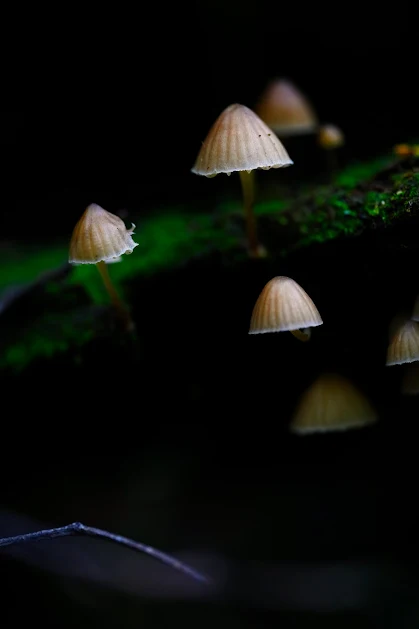Returning to the same spot each year yields the familiar sight of mushrooms—unchanged in form, yet ever transformed by the shifting light and atmosphere. It is a quiet pleasure to observe and capture their delicate textures through the lens of a macro camera, where each detail is magnified and newly appreciated. At Mount Macedon, where the air is almost perpetually damp and the mists linger among the trees, the forest floor remains a fertile haven for fungi. The endemic weather—cool, wet, and cloaked in a veil of fog—imbues the landscape with a subdued beauty, making each photographic outing a contemplative and rewarding pursuit.
Sony A7RV
Sigma 105mm f2.8 Macro
Linking Sunday Best
Of late, I have been viewing the series Naked and Afraid: Last One Standing, which piqued my curiosity regarding the distinction between the nyala and the impala, both of which are frequently mentioned or encountered in such wilderness settings. Compelled by this interest, I sought further understanding through study and inquiry.
The impala is a slender, graceful antelope renowned for its agility and speed, commonly found across the savannas and light woodlands of eastern and southern Africa. It bears a reddish-brown coat, with males distinguished by their lyre-shaped, ridged horns. Social in nature, impalas are often seen in large herds and rely on their swiftness to evade predators.
In contrast, the nyala is a more reclusive and strikingly patterned antelope, typically inhabiting dense bushlands and thickets, particularly in southern Africa. Males are darker in colour—deep brown to slate grey—with prominent vertical white stripes, spiral horns, and a shaggy appearance marked by a mane and white facial markings. Females and juveniles, by contrast, are lighter in hue and more modestly adorned.
Thus, while both species are antelopes of the African wild, they differ notably in habitat, temperament, and physical characteristics—the impala embodying fleet elegance in open terrain, and the nyala exuding quiet dignity in the shelter of the bush.



Beautiful and enchanting.
ReplyDeleteDifferent ways to photograph the same fungus
DeleteImpressive photo of mushrooms! I would like to find at least one mushroom where I live.
ReplyDeleteThese are poisonous
DeleteThis is a very impressive photo. Love it.
ReplyDeleteLooks a tad juicy
DeletePocas veces he encontrado hongos por el campo.
ReplyDeleteIt has to be wet near Rotton woods
DeleteYour high contrast photo makes these mushrooms stand out. Mushrooms are fascinating to see as they are the fruiting bodies of the mycelium living below ground. Some are edible, some not.
ReplyDeleteThank you Jeff. You make a good host for any events
DeleteLovely mushrooms :-D
ReplyDeleteI like the polished look of it
DeleteNice, they look like little lamp shades.
ReplyDeleteThey do!
DeleteSpookily mysteriously beautiful!
ReplyDeletePreciosa, parece como si los hongos tuvieran luz propia.
ReplyDeleteWe visit the same spots, and we take the same photos, but they never are the same are they?
ReplyDeleteMushrooms are such a beautiful subject!!
ReplyDeleteThey look so delicate in your perfect photo!!
They certainly are beautiful. Often pays to go to the same place as you know they will be there.
ReplyDeleteSuper pictures! They almost look like jellyfish in the sea.
ReplyDeleteNice those little lamps. Great photo's again.
ReplyDeleteI often cook with mushrooms because the taste is fresh and delicate. But I now check the source VERY carefully.
ReplyDeleteYours may look perfectly symmetrical, but you say they are poisonous????
Una gran foto de esos hongos que parecen ser traslucidos.
ReplyDeleteSaludos.
This is a lovely shot.
ReplyDeleteAlmost otherworldly. Beautiful shot.
ReplyDeleteThank you for joining the Awww Mondays Blog Hop.
Have a fabulous Awww Monday and week. ☺
Thank for not sharing what's happening in the competition, Roentare. I love "Naked and Afraid, Last One Standing," but I haven't had a tv in a month, so I'm behind. Soon I'll have a tv ~ 🤞😂. I often see Nyala and Impala on the Tembe Elephant Park live cam in Emangusi, South Africa. They are beautiful animals. You captured the delicacy of the mushrooms.
ReplyDeleteGood shot! Thank you for taking part in the "My Sunday Best" meme
ReplyDelete